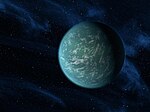WD 0806-661
WD 0806-661 B
Component WD 0806-661 B was discovered in 2011 with the Spitzer Space Telescope. Its discovery was announced in the paper Luhman et al., 2011. The secondary has a mass between 7 and 9 MJ and a temperature between 325 and 350 kelvins (52 and 77 °C; 125 and 170 °F). At the time of its discovery, WD 0806−661 B was the coldest "brown dwarf" that has ever been found. The object is too faint to acquire a spectrum even with the Hubble Space Telescope, however the spectral type of this object was estimated to be Y1 based on its detection in Hubble images at near-infrared wavelengths. The photometric colors of this object suggest that it is metal-poor. The metal-poor composition of the companion could explain the DQ spectral type of the primary white dwarf. Hydrogen-deficient AGB stars might evolve into DB white dwarfs and then into DQ white dwarfs as they cool down.
In August 2022, WD 0806-661 and its planetary-mass companion were included among 20 systems to be named by the third NameExoWorlds project. The approved names, proposed by a team from South Korea, were announced in June 2023. WD 0806-661 is named Maru and its companion is named Ahra, after Korean words meaning "sky" and "ocean".
See also
- List of exoplanets and planetary debris around white dwarfs
- WISE 0146+4234 – a Y0 companion to a T9 brown dwarf
- WISE 1217+1626 B – another Y0 companion to a T9 brown dwarf
- DT Virginis
- HD 106906 b
- GU Piscium b
References
- ^ "GJ 3483 – White Dwarf". SIMBAD. Centre de données astronomiques de Strasbourg. Retrieved 2012-06-19.
- ^ Vallenari, A.; et al. (Gaia collaboration) (2023). "Gaia Data Release 3. Summary of the content and survey properties". Astronomy and Astrophysics. 674: A1. arXiv:2208.00211. Bibcode:2023A&A...674A...1G. doi:10.1051/0004-6361/202243940. S2CID 244398875. Gaia DR3 record for this source at VizieR.
- ^ Holberg, J. B.; Sion, E. M.; Oswalt, T.; McCook, G. P.; Foran, S.; Subasavage, John P. (2008). "A New Look at the Local White Dwarf Population". The Astronomical Journal. 135 (4): 1225–1238. Bibcode:2008AJ....135.1225H. doi:10.1088/0004-6256/135/4/1225. S2CID 122855486.
- ^ Sion, Edward M.; Holberg, J. B.; Oswalt, Terry D.; McCook, George P.; Wasatonic, Richard (2009). "The White Dwarfs Within 20 Parsecs of the Sun: Kinematics and Statistics". The Astronomical Journal. 138 (6): 1681–1689. arXiv:0910.1288. Bibcode:2009AJ....138.1681S. doi:10.1088/0004-6256/138/6/1681. S2CID 119284418.
- ^ Leggett, S. K.; Morley, Caroline V.; Marley, M. S.; Saumon, D. (January 2015). "Near-infrared Photometry of Y Dwarfs: Low Ammonia Abundance and the Onset of Water Clouds". The Astrophysical Journal. 799 (1): 37. arXiv:1411.2020. Bibcode:2015ApJ...799...37L. doi:10.1088/0004-637X/799/1/37. ISSN 0004-637X. S2CID 118530454.
- ^ Giammichele, N.; Bergeron, P.; Dufour, P. (2012). "Know Your Neighborhood: A Detailed Model Atmosphere Analysis of Nearby White Dwarfs". The Astrophysical Journal Supplement. 199 (2): 29. arXiv:1202.5581. Bibcode:2012ApJS..199...29G. doi:10.1088/0067-0049/199/2/29. S2CID 118304737.
- ^ Leggett, S. K.; Tremblin, P.; Esplin, T. L.; Luhman, K. L.; Morley, Caroline V. (June 2017). "The Y-type Brown Dwarfs: Estimates of Mass and Age from New Astrometry, Homogenized Photometry, and Near-infrared Spectroscopy". The Astrophysical Journal. 842 (2): 118. arXiv:1704.03573. Bibcode:2017ApJ...842..118L. doi:10.3847/1538-4357/aa6fb5. ISSN 0004-637X. S2CID 119249195.
- ^ Luhman, K. L.; Burgasser, Adam J.; Bochanski, J. J. (2011). "Discovery of a Candidate for the Coolest Known Brown Dwarf". The Astrophysical Journal Letters. 730 (1): L9. arXiv:1102.5411. Bibcode:2011ApJ...730L...9L. doi:10.1088/2041-8205/730/1/L9. S2CID 54666396.
- ^ "2022 Approved Names". nameexoworlds.iau.org. IAU. Retrieved 7 June 2023.
- ^ Althaus, L. G.; Serenelli, A. M.; Panei, J. A.; Córsico, A. H.; García-Berro, E.; Scóccola, C. G. (May 2005). "The formation and evolution of hydrogen-deficient post-AGB white dwarfs: The emerging chemical profile and the expectations for the PG 1159-DB-DQ evolutionary connection". Astronomy and Astrophysics. 435 (2): 631–648. arXiv:astro-ph/0502005. Bibcode:2005A&A...435..631A. doi:10.1051/0004-6361:20041965. ISSN 0004-6361.
- ^ "List of ExoWorlds 2022". nameexoworlds.iau.org. IAU. 8 August 2022. Retrieved 27 August 2022.


